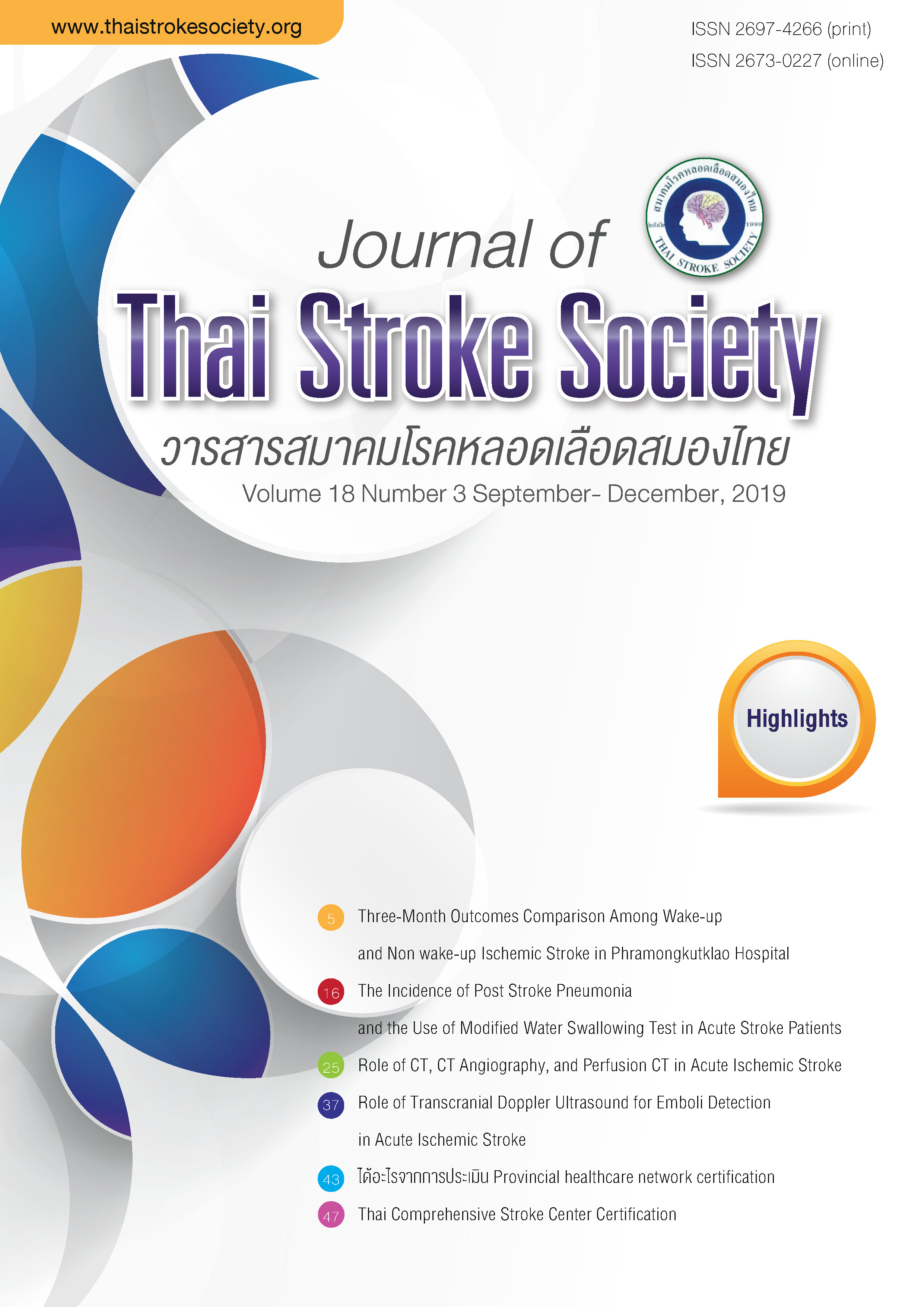Role of CT, CT Angiography, and Perfusion CT in Acute Ischemic Stroke
Keywords:
acute ischemic stroke, noncontrast computed tomography, CT angiography, perfusion CTAbstract
Acute ischemic stroke is one the leading causes of disability and death. Neuroimaging is necessary for stroke assessment. Computed tomography (CT) is the first line tool for acute stroke due to its availability and cost-effectiveness. Using noncontrast CT combined with CT angiography and perfusion CT can provide necessary information to impact acute treatment decision making. The current goal of neuroimaging is not only to diagnose acute ischemic stroke but to select appropriate treatment for each patient. This review points out an update on the role of each CT modalities in acute ischemic stroke.
References
2. Leiva-Salinas C, Jiang B, Wintermark M. Computed tomography, computed tomography angiography, and perfusion computed tomography evaluation of acute ischemic stroke. Neuroimaging Clinics. 2018;28(4):565-72.
3. Powers WJ, Rabinstein AA, Ackerson T, Adeoye OM, Bambakidis NC, Becker K, et al. 2018 guidelines for the early management of patients with acute ischemic stroke: a guideline for healthcare professionals from the American Heart Association/American Stroke Association. Stroke. 2018;49(3):e46-e99.
4. de Lucas EM, Sánchez E, Gutiérrez A, Mandly AG, Ruiz E, Flórez AF, et al. CT protocol for acute stroke: tips and tricks for general radiologists. Radiographics. 2008;28(6):1673-87.
5. Barber PA, Demchuk AM, Zhang J, Buchan AM, Group AS. Validity and reliability of a quantitative computed tomography score in predicting outcome of hyperacute stroke before thrombolytic therapy. The Lancet. 2000;355(9216):1670-4.
6. Pexman JW, Barber PA, Hill MD, Sevick RJ, Demchuk AM, Hudon ME, et al. Use of the Alberta Stroke Program Early CT Score (ASPECTS) for assessing CT scans in patients with acute stroke. American Journal of Neuroradiology. 2001;22(8):1534-42.
7. Konstas AA, Minaeian A, Ross IB. Mechanical thrombectomy in wake-up strokes: a case series Using Alberta Stroke Program Early CT Score (ASPECTS) for patient selection. J Stroke Cerebrovasc Dis. 2017;26(7):1609-14.
8. Jensen-Kondering U, Riedel C, Jansen O. Hyperdense artery sign on computed tomography in acute ischemic stroke. World journal of radiology. 2010;2(9):354.
9. Berkhemer OA, Fransen PS, Beumer D, van den Berg LA, Lingsma HF, Yoo AJ, et al. A randomized trial of intraarterial treatment for acute ischemic stroke. N Engl J Med. 2015;372(1):11-20.
10. Goyal M, Demchuk AM, Menon BK, Eesa M, Rempel JL, Thornton J, et al. Randomized assessment of rapid endovascular treatment of ischemic stroke. N Engl J Med. 2015;372(11):1019-30.
11. Saver JL, Goyal M, Bonafe A, Diener H-C, Levy EI, Pereira VM, et al. Stent-retriever thrombectomy after intravenous t-PA vs. t-PA alone in stroke. N Engl J Med. 2015;372(24):2285-95.
12. Jovin TG, Saver JL, Ribo M, Pereira V, Furlan A, Bonafe A, et al. Diffusion-weighted imaging or computerized tomography perfusion assessment with clinical mismatch in the triage of wake up and late presenting strokes undergoing neurointervention with Trevo (DAWN) trial methods. Int J Stroke. 2017;12(6):641-52.
13. Riedel CH, Zimmermann P, Jensen-Kondering U, Stingele R, Deuschl G, Jansen O. The importance of size: successful recanalization by intravenous thrombolysis in acute anterior stroke depends on thrombus length. Stroke. 2011;42(6):1775-7.
14. Mishra S, Dykeman J, Sajobi T, Trivedi A, Almekhlafi M, Sohn S, et al. Early reperfusion rates with IV tPA are determined by CTA clot characteristics. American Journal of Neuroradiology. 2014;35(12):2265-72.
15. Menon BK, d’Esterre CD, Qazi EM, Almekhlafi M, Hahn L, Demchuk AM, et al. Multiphase CT angiography: a new tool for the imaging triage of patients with acute ischemic stroke. Radiology. 2015;275(2):510-20.
16. Coutts SB, Lev MH, Eliasziw M, Roccatagliata L, Hill MD, Schwamm LH, et al. ASPECTS on CTA source images versus unenhanced CT: added value in predicting final infarct extent and clinical outcome. Stroke. 2004;35(11):2472-6.
17. Sallustio F, Motta C, Pizzuto S, Diomedi M, Rizzato B, Panella M, et al. CT angiography ASPECTS predicts outcome much better than noncontrast CT in patients with stroke treated endovascularly. American Journal of Neuroradiology. 2017;38(8):1569-73.
18. Allmendinger AM, Tang ER, Lui YW, Spektor V. Imaging of stroke: Part 1, Perfusion CT-- overview of imaging technique, interpretation pearls, and common pitfalls. American Journal of Roentgenology. 2012;198(1):52-62.
19. Hosseini MB, Liebeskind DS. The role of neuroimaging in elucidating the pathophysiology of cerebral ischemia. Neuropharmacology. 2018;134:249-58.
20. Fieselmann A, Kowarschik M, Ganguly A, Hornegger J, Fahrig R. Deconvolution-based CT and MR brain perfusion measurement: theoretical model revisited and practical implementation details. Journal of Biomedical Imaging. 2011;2011:14.
21. Albers GW, Marks MP, Kemp S, Christensen S, Tsai JP, Ortega-Gutierrez S, et al. Thrombectomy for stroke at 6 to 16 hours with selection by perfusion imaging. N Engl J Med. 2018;378(8):708-18.
22. Austein F, Riedel C, Kerby T, Meyne J, Binder A, Lindner T, et al. Comparison of perfusion CT software to predict the final infarct volume after thrombectomy. Stroke. 2016;47(9):2311-7.
23. ASPECT Score in Acute Stroke. Basic Stroke Imaging Findings [Internet]. 2019 [cited 14 Feb. 2019]. Available from: https://aspectsinstroke. com/casepacs/imaging-findings-of-stroke.
Downloads
Published
How to Cite
Issue
Section
License
ข้อความภายในบทความที่ตีพิมพ์ในวารสารสมาคมโรคหลอดเลือดสมองไทยเล่มนี้ ตลอดจนความรับผิดชอบด้านเนื้อหาและการตรวจร่างบทความเป็นของผู้นิพนธ์ ไม่เกี่ยวข้องกับกองบรรณาธิการแต่อย่างใด การนำเนื้อหา ข้อความหรือข้อคิดเห็นของบทความไปเผยแพร่ ต้องได้รับอนุญาตจากกองบรรณาธิการอย่างเป็นลายลักษณ์อักษร ผลงานที่ได้รับการตีพิมพ์ในวารสารเล่มนี้ถือเป็นลิขสิทธิ์ของวารสาร





